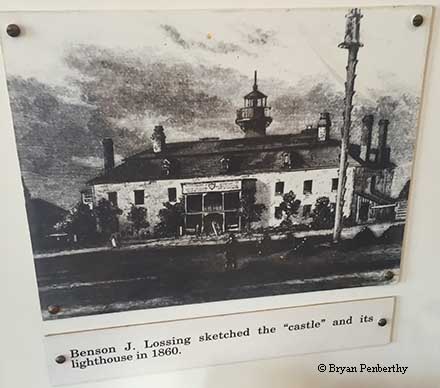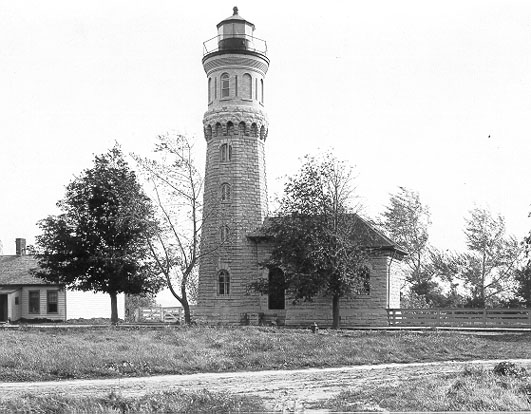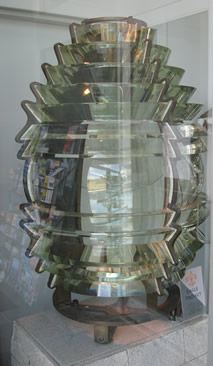Fort Niagara Lighthouse
Youngstown, New York - 1872 (1782**)

History of the Fort Niagara Lighthouse
Posted/Updated by Bryan Penberthy on 2014-10-30.
For the early settlers of America, the Great Lakes and their connecting bodies of water formed a natural system of highways to the interior of the continent. The Fort Niagara Lighthouse served to mark the one of the few natural harbors on Lake Ontario and a vital portage route around Niagara Falls.
To explore the upper Great Lakes, the French sought to construct a sailing vessel above Niagara Falls. They received permission from the Iroquois to use the Niagara Portage route and to support the shipbuilding project, Rene Cavelier, Sieur de LaSalle established Fort Conti at the mouth of the Niagara River and Lake Ontario in 1679. The fort would accidentally burn down in less than a year.
The French knew that they had to control the vital Niagara Portage route at all costs to keep if from falling into the hands of the British, and in 1687, troops erected a stockade which they named Fort Denonville, which the Iroquois viewed as an unwelcome enemy presence.
By September of 1688, the French had abandoned Fort Denonville and by the early 1700s, the French and British were in open conflict. This conflict drove the French to again seek control the Niagara Portage route.
To achieve their goal, The French sought the permission of the Five Nations of Indians to construct a "trading house of stone." They termed it a "house of peace" in which to exchange goods for furs. Once they received permission, they actually designed a "machicolated house" enclosed by a wooden stockade, which was common for North American trading posts.
Fort Niagara was completed by 1727. Its main feature, the "French Castle," was designed to look like a trading house, but it was actually a garrison, complete with a storeroom, quarters, and a well capable of resisting an Indian attack.
During the French and Indian War, the Iroquois had sided with the British after long-standing resentment of Fort Niagara, and in July of 1759, the British were successful in capturing the fort.
With the advent of larger sailing vessels, the British established the first lighthouse at Fort Niagara in 1782. The light was mounted on a pedestal constructed on the roof of the "French Castle," and outfitted with whale-oil fueled lamps and reflectors. This is largely considered the first lighted aid to navigation on the Great Lakes.
Following the Revolutionary War, although Fort Niagara fell within the boundary of the United States, the British continued to occupy it until 1796 while building Fort George across the river in Canada. By 1806, the pedestal light on the castle was removed.
In 1804, the British established a lighthouse at Mississauga Point called the Newark Lighthouse near what is modern day Niagara-on-the-Lake. It had only been in use for ten years, before being razed to clear the site for Fort Mississauga.
 The first lighthouse atop the French Castle
The first lighthouse atop the French Castle
Although the many towns of the lower Niagara River remained busy with trade, they did so without the assistance of a beacon. In 1823, the United States sought to reestablish a lighthouse, and Fort Niagara was the logical choice. Once again, a squat, octagonal pedestal was constructed on the roof of the French Castle. Inside the lantern was a catoptric array of several Winslow Lewis patented lamps and 14" reflectors. The keeper was provided a small house, outside of the fort, on the banks of the river.
Later, the keeper was moved to another small house, higher up, closer to the main entrance to the fort. However, to service the light, he had to enter the fort, and carry equipment through the officer's quarters, up several flights of stairs, several times a day.
The western terminus of the Erie Canal was completed in 1825, linking Buffalo to New York City. This redirected a lot of the traffic from the towns of the lower Niagara and portage route to Buffalo, which helped Buffalo rapidly evolve into a port city. Even though the traffic to the lower Niagara diminished, it didn't disappear, and the lighthouse remained in service
The portage route worked like this: ships with cargo would sail from the eastern points of Lake Ontario to a town on the lower Niagara River. There the cargo would be unloaded and would travel overland via horse to a port on Lake Erie, where it would be reloaded onto a ship to continue its journey westward.
The opening of the Welland Canal in 1829 eliminated the need to unload the cargo, thus eliminating the Portage route altogether. Despite this setback, the lighthouse remained in service.
An 1838 report of Lieutenant Charles T. Platt, U.S. Navy, listed the light as "situated on the mess-house, within Fort Niagara, at an elevation of 70 feet above the water." The report goes on to praise the keeper for "the excellent order in which it is conducted" and also noted that the dwelling was in excellent condition.
On April 18, 1855, a tornado struck the Niagara Frontier region and heavily damaged the fort. The St. Catherines Constitutional reported "a portion of the wall surrounding the American Fort on the opposite side of the river was torn completely from its foundation."
The Annual Report of the Secretary of the Treasury on the State of Finances for the year ending June 30, 1855 stated that "expenditures at Fort Niagara were incurred in roofing the dwelling and outbuildings, which were damaged by the tornado."
That same year, the Lighthouse Board had recommended that Fort Niagara get a fourth-order Fresnel lens with a 270° arc illuminated by a valve lamp and two concentric burners. The lens was installed two years later, in 1857.
By 1868, the description of the Fort Niagara Lighthouse wasn't favorable:
22. Niagara Fort - The wooden tower stands in the old block-house now used for officers' quarters, and is so old and out of repair as to let in the snow and rain in stormy weather. Last winter the roof of the building took fire from a spark from one of the four chimneys which surround the tower. The danger of having the valuable lens destroyed by an accident of this kind, and the inconvenience of using the stairway and passages of the officers' quarters as a thoroughfare for the supply of the light, make it expedient to erect a new tower, (the old one not being worth repairing,) in a safer and more convenient position.
The floors and plastering of the keeper's dwelling and the fences require repair. The barn is in a ruinous state, and should be removed or rebuilt.
 Fort Niagara Lighthouse (Courtesy Coast Guard)
Fort Niagara Lighthouse (Courtesy Coast Guard)
The following year, most of those items were taken care of including the construction of a new woodshed, privy, and a barn. The final sentence of the report requests a new structure: "The importance of this station, as a coast and harbor light, seems to require the erection of a more suitable and more permanent structure at an early day."
A report of 1870 goes on to say, "The position is not a proper one for a light, and as the tower is in a most dilapidated condition, without oil-room or other necessary means of keeping the oil and other supplies" and requests that a new lighthouse to be constructed "on a suitable site" that serves as both a lake coast and local harbor light.
On March 3, 1871, Congress appropriated $16,000 for a new lighthouse with an attached oil room. The plans called for the tower to be constructed of coursed rubble stone with an eighteen foot diameter at the base, tapering to 11 feet at the top, with a focal plane of forty-five feet above the ground. The 1857 fourth-order Fresnel lens would be moved over to the new lantern.
As no suitable location could be found within the fort, the next best location was to place the tower next to the keeper's dwelling along the banks of the Niagara River. Construction of the lighthouse started in July of 1871, and was postponed on November 30 due to the onset of winter.
Work resumed on April 15, 1872 and by June 10, a light was exhibited from the tower, even though the rest of the tower wasn't completely finished until June 27. After work on the tower was completed, the shores of the riverbank were inspected, and a retaining wall of timber, filled with stones was constructed.
From watching the reports over the next few years, it appears that only minor repairs to the station were made. However, in 1880, the cellar floor of the dwelling was cemented, and the dwelling was repainted as well. The oil room received some repairs and a locker was built within the tower.
Several years later, in 1885, two 215-foot long sections of fence were rebuilt along the sides of the dwelling, down the embankment, towards the river to fence-off the station. In 1890, water was brought over from Fort Niagara by running a supply line to the keeper's dwelling. That same year, a new 12-foot by 16-foot shed was built.
 Fourth-order Fresnel lens
Fourth-order Fresnel lens
A year later, the timber retaining wall constructed in 1872 was rebuilt. The 100 drift bolts used to fasten the timbers together were taken from the destroyed pier at Oswego, NY.
By 1893, the keeper's dwelling was described as "old, in bad condition, and unsuitable." The lighthouse Board recommended that it could be rebuilt for less than $4,000 and recommended the appropriation be made.
It would take several years, but finally a contract to rebuild the keeper's dwelling was signed on June 25, 1896. The Annual Report of the Lighthouse Board for 1897 had the following entry:
1206. Fort Niagara, Niagara River, Lake Ontario, New York - Under the contract of June 25, 1896, the keeper's dwelling was rebuilt. The grade of the lot around the dwelling was raised and a walk was built across the rear end of the dwelling. A gravel driveway leading from the street to the lot was made, and 100 feet of fence was rebuilt on the street line.
By 1899, the Lighthouse Board was recommending a small light at the mouth of the Niagara River, noting that it would decrease the danger in making it into port on dark nights and in stormy weather. They also noted that the Niagara River is the only harbor of refuge on the southern shore of Lake Ontario between the Genessee River and Port Dalhousie capable of handing ships drawing more than 10 feet of water.
The Lighthouse Board had recommended a tower standing 25-feet tall, which could be established on government land, for $2,000 and asked for the appropriation. The following year, the Fort Niagara Lighthouse was raised 11 feet and 4 inches, creating a watch room underneath the lantern. The addition is easily noticeable in pictures of the lighthouse.
In 1902, various repairs were made to the station, including the rebuilding of a woodshed, taking down the old barn, and constructing a new concrete retaining wall behind the tower, along the banks of the river.
It appears that little progress was made for the small light at the mouth of the Niagara River, and the same request appeared in each Annual Report of the Lighthouse Board from 1899 through 1904, with the report of 1904 increasing the cost to $2,200 due to the rising cost of materials and wages. However, it doesn't appear that any small light was ever established.
In preparation for a transfer from the War Department to the Department of Commerce and Labor, a survey was conducted in 1905. The following year, an iron oil house with a capacity of 540 gallons was erected 25 feet south of the tower.
The lighthouse was automated in 1983. The Coast Guard faced a dilemma ten years later as many trees were obscuring the light of the Fort Niagara Lighthouse. They could either trim or remove them, or discontinue the lighthouse.
The Coast Guard chose to discontinue the lighthouse, and instead, replace it with an automated light on a radio tower, northwest of the fort. On December 9, 1998, the lighthouse property was conveyed to the New York State Office of Parks, Recreation, and Historic Preservation. It was later incorporated into the Fort Niagara State Park.
In 2006, a new visitor center was opened featuring many displays including the 1857 fourth-order Fresnel lens that was used in the lantern on the French Castle and in the 1872 tower until 1993. Today, the lighthouse and the fort are managed by the Old Fort Niagara Association with tours run year round.
Reference:
- Annual Report of the Light House Board, U.S. Lighthouse Service, Various years.
- Various Government Documents, Federal & State Governments, Various dates.
- "Lost Lights of the Great Lakes - Part 7," Wayne S. Sapulski, The Beacon, Summer 2014.
- www.oldfortniagara.org website.
Directions: The lighthouse sits on the grounds of Fort Niagara State Park. Follow the Robert Moses State Parkway out of Niagara Falls towards Youngstown, NY. The parkway will split, you will follow the split towards Fort Niagara State Park. There is a charge to enter the park and the light is visible from the parking area before you enter the fort itself.
Access: The Lighthouse is owned by the State of New York, and is managed by the Old Fort Niagara Association. The grounds are open year round. The tower is open several times throughout the year for tours.
View more Fort Niagara Lighthouse picturesTower Height: 61.00'
Focal Plane: 91'
Active Aid to Navigation: Deactivated (1993)
*Latitude: 43.26176 N
*Longitude: -79.06045 W
See this lighthouse on Google Maps.
